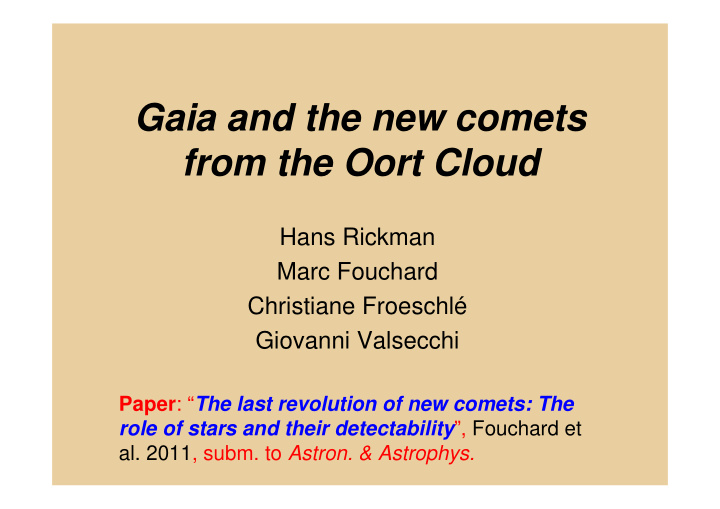



Gaia and the new comets from the Oort Cloud Hans Rickman Marc Fouchard Christiane Froeschlé Giovanni Valsecchi Paper : “ The last revolution of new comets: The role of stars and their detectability ”, Fouchard et al. 2011, subm. to Astron. & Astrophys.
The Oort Cloud • Entering into the planetary system, the long-period comets have a strongly peaked distribution of 1/a • But planetary perturbations wipe out the spike • The comets of the spike are not returning - they are newcomers from a very distant reservoir the Oort spike - “Old” and “New” comets
Comet injectors • The tidal force of the Galactic disk (‘ disk tide’ ) causes an oscillation of eccentricity and inclination of Oort Cloud comet orbits, which may bring perihelion distances below ~5 AU (thus observable) • Random passing stars of the Galactic field impart heliocentric impulses to the comets, thus changing their perihelion distances
Our work • We start 10 6 test comets in thermalized Oort Cloud orbits and integrate them up to 5 Gyr, unless they enter the loss cylinder or diffuse into interstellar space • We use a full description of the Galactic tide and a random set of stellar encounters using 13 categories with different masses and velocity distributions • We take note of all injections into observable orbits ( q < 5 AU)
Stellar encounters
Method • Create 3 different initial Oort Clouds (10 6 -1.5 between 3000 and orbits with p(a o ) ∝ a o 10 5 AU, and p(e o ) ∝ e o with q o > 32 AU • For each cloud, create a random sequence of ~200,000 stellar encounters during 5 Gyr • Integrate with tides and stars until comets diffuse out or get injected into r < 15 AU • For observable comets (r < 5 AU), save the elements at the preceding perihelion passage
Eliminating showers • The present flux of new comets is likely not affected by any “comet shower” • Thus we select the most “quiescent” injected comets by excluding all that might have been perturbed by a star causing a significant enhancement • We are able to statistically identify all such stars using a separate study of comet injection ( Icarus , in press)
Numbers of stars and comets • During the last 3 Gyr: – 355,821 passing V (km/s) stars, whereof 755 enhancement makers – 20,446 injected comets, whereof only d � (AU) 30% are quiescent • Conservative Passing stars: enhancement makers identified with symbol definition! size indicating the stellar mass
The S and G sets • S is the set of • G is the set of injected comets, for injected comets, for which a tide-only which one star backward caused a jump from integration to the > 15 AU to < 5 AU in preceding perihelion q during the last leads to q > 15 AU revolution (“ tidal injections ”) (“ stellar injections ”) Most comets belong to S or G , but some belong to both, and some belong to none…
S Injection types Syn. G
Constructive interference • Black line: fraction of G-set comets that require a star to be injected • Grey line: fraction of injections in a tide-only model that disappear when stars are added
Simulated Oort spike fraction of injected comets • G-type injections dominate the spike • But stars are essential in many cases near the maximum and almost always in the outer part
Stars are important! • The Galactic tide appears to be the dominant player in the game of comet injection (the G set dominates the Oort spike) • But most of the injections in general (all on the inner side of the spike and almost all on the outer side) would not have occurred without the action of a star
Comet injection: A Team Work Scoring goals is important, … … but the backup of the whole team is essential!
The culprit stars • For many of the observed new comets, the injection was assisted by a stellar perturbation • Can we identify the culprit stars using existing catalogues? • Dybczy ń ski (2006) made a state-of-the-art search for encounters with Hipparcos stars in the recent past & near future – He identified 11 stars to have passed at < 2 pc during the last 3 Myr; none caused the injection (J-S barrier crossing) of any of the “new comets”
Detection criteria • GAIA • HIPPARCOS • V<20: all detected • V<8: all detected • V>20: none detected • V>13: none detected • r<500 pc: all measured • 8<V<13: linear falloff of probability • p.m.>4 μ as/yr: measured for V<12 • p.m.>1 mas/yr: all • p.m.>10 μ as/yr: measured measured for 12<V<17 • p.m.>160 μ as/yr: measured • p.m.<1 mas/yr: none measured for V>17
General results • For all injected comets, we compute magnitude & proper motion of all stars that passed during the last orbit at the moment of comet perihelion • For Hipparcos, ~10% are detected, and for Gaia, ~70% are detected • Taking the star with the largest negative Δ q, for Hipparcos we get ~30% and for Gaia ~90% • The fraction of p.m. measurements for all detected stars is 73% for Hipparcos and 95% for Gaia; for the most efficient detected stars it is ~20% and >80%, respectively
Random illustration Hipparcos detections Gaia detections Dybczy ń ski’s real stars
The culprit hunt using Gaia • Get radial velocities for Gaia stars with very small proper motions, unless Gaia can measure them ⇒ identification of possible culprits • Get better astrometry for distant, new comets for better orbits (preferably large perihelia to minimize NG effects) ⇒ possible links of comets to stars
Recommend
More recommend